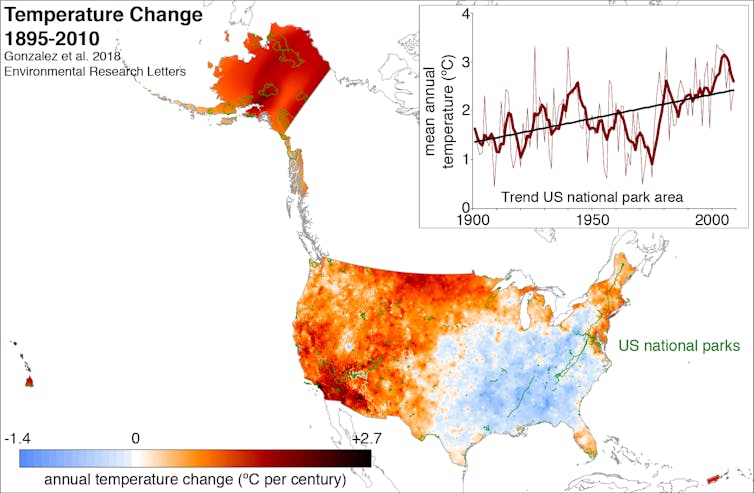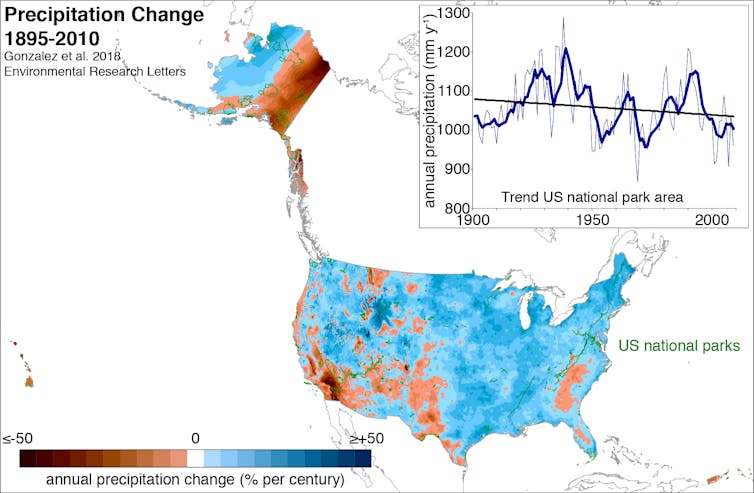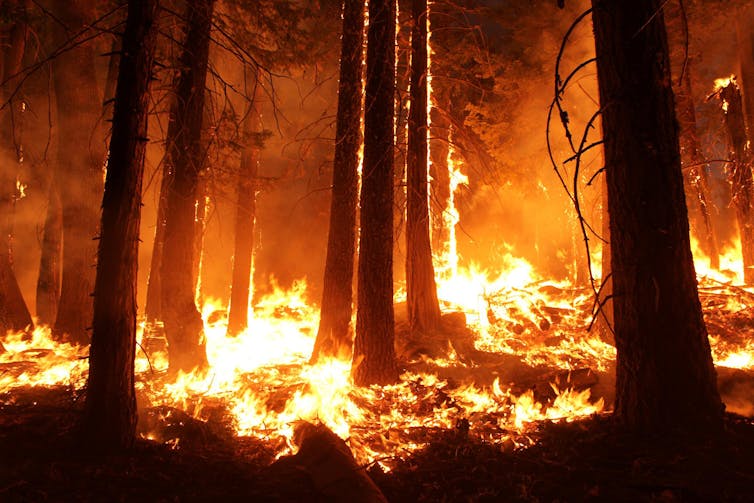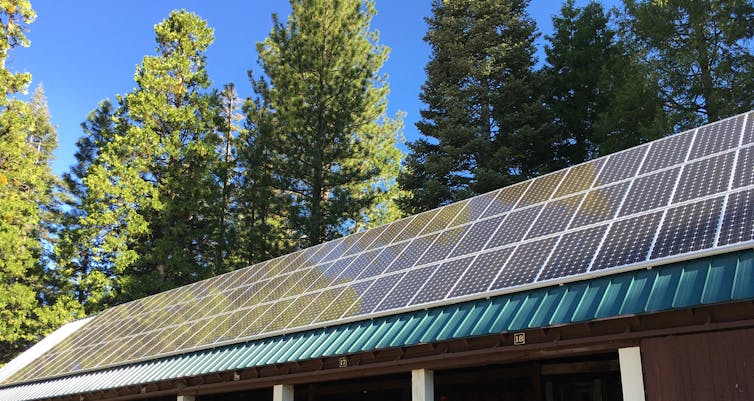Human-caused climate change severely exposes the US national parks
- Written by Patrick Gonzalez, Associate Adjunct Professor, University of California, Berkeley
Human-caused climate change is disrupting ecosystems[1] and people’s lives[2] around the world. It is melting glaciers[3], increasing wildfires[4], and shifting vegetation[5] across vast landscapes. These impacts have reached national parks around the world and in the United States[6]. Until now, however, no analysis had examined climate change trends across all 417 U.S. national parks.
The United States established the first national park in the world, Yellowstone National Park[7], in 1872. U.S. national parks today protect some of the most irreplaceable natural areas and cultural sites in the world. Colleagues and I aimed to uncover the magnitude of human-caused climate change on these special places. We conducted the first spatial analysis of historical and projected temperature and precipitation trends across all U.S. national parks and compared them with national trends.
Our newly published results[8] reveal that climate change has exposed the national parks to conditions hotter and drier than the country as a whole. This occurs because extensive parts of the parks are in extreme environments – the Arctic, high mountains, and the arid southwestern United States.
 Many national parks are located in regions with the fastest rates of warming in the United States.
Patrick Gonzalez, CC BY[9]
Many national parks are located in regions with the fastest rates of warming in the United States.
Patrick Gonzalez, CC BY[9]
Rapid warming and drying
National parks conserve the most intact natural places in the country. They harbor endangered plants and animals and unique ecosystems. They also help assure human well-being by protecting watersheds that provide drinking water[10] to people and by storing carbon[11], which naturally reduces climate change.
Our findings show that temperatures in the national park area increased at double the national rate from 1895 to 2010. At the same time, precipitation decreased across a greater fraction of the national park area than across the United States as a whole.
Our analysis of climate trends starting in 1895 showed that temperatures increased most in Denali National Preserve, Alaska, and rainfall declined most in Honouliuli National Monument, Hawaii. Hotter temperatures from human-caused climate change have intensified droughts caused by low precipitation in California and the southwestern United States.
 Many national parks in the southwestern U.S. have experienced intense drought.
Patrick Gonzalez, CC BY[12]
Many national parks in the southwestern U.S. have experienced intense drought.
Patrick Gonzalez, CC BY[12]
Human-caused climate change has caused historical impacts in places where we found significant past temperature increases. These impacts include melting of glaciers[13] in Glacier Bay National Park, Alaska, tree death from bark beetles[14] in Yellowstone National Park, upslope vegetation shifts[15] in Yosemite National Park, California, and northward vegetation shifts[16] in Noatak National Preserve, Alaska.
To quantify potential future changes, we analyzed all available climate model projections from the Intergovernmental Panel on Climate Change[17]. Continued greenhouse gas emissions under the highest emissions scenario could increase U.S. temperatures in the 21st century six times faster than occurred in the 20th century.
This could increase temperatures in national parks up to 9 degrees Celsius by 2100, with the most extreme increases in Alaska, and reduce precipitation by as much as 28 percent, in the national parks of the U.S. Virgin Islands. Heating could outpace the ability of many plant and animal species to move and stay in suitable climate spaces.
In places where models project high temperature increases, research has found high vulnerabilities of ecosystems. These vulnerabilities include severely increased wildfire[18] in Yellowstone National Park, extensive death of Joshua trees[19] in Joshua Tree National Park, California, and possible disappearance[20] of American pika, a small alpine mammal, from Lassen Volcanic National Park, California.
 Human-caused climate change has doubled wildfire in the western U.S. Here, the Rim Fire burns west of Yosemite National Park, Calif., in 2013.
USDA/Mike McMillan, CC BY[21][22]
Human-caused climate change has doubled wildfire in the western U.S. Here, the Rim Fire burns west of Yosemite National Park, Calif., in 2013.
USDA/Mike McMillan, CC BY[21][22]
Our research provides climate data to analyze vulnerabilities of plants, animals and ecosystems. The data can also help park managers develop adaptation measures for fire management, invasive species control and other ways to protect parks in the future.
For example, based on analyses of the vulnerability of ecosystems to increased wildfire under climate change, parks can target prescribed burning and wildland fire in the short term to reduce the unnatural buildup of fuels that can cause catastrophic wildfires in the long term.
 A solar panel on the roof of a building in Lassen Volcanic National Park, Calif., reduces greenhouse gas emissions and electricity costs for the park.
Patrick Gonzalez, CC BY-ND[23]
A solar panel on the roof of a building in Lassen Volcanic National Park, Calif., reduces greenhouse gas emissions and electricity costs for the park.
Patrick Gonzalez, CC BY-ND[23]
Reducing emissions can help parks
Ultimately, our results indicate that reducing greenhouse gas emissions[24] from cars, power plants and other human sources can save parks from the most extreme heat. Compared to the highest emissions scenario, reduced emissions would lower the rate of temperature increase in the national parks by one-half to two-thirds by 2100.
Cutting greenhouse gas emissions through energy conservation, improved efficiency, renewable energy, public transit and other actions would reduce the magnitude of human-caused climate change, helping save the U.S. national parks for future generations.
References
- ^ ecosystems (www.ipcc.ch)
- ^ people’s lives (www.ipcc.ch)
- ^ melting glaciers (science.sciencemag.org)
- ^ increasing wildfires (www.pnas.org)
- ^ shifting vegetation (onlinelibrary.wiley.com)
- ^ United States (www.patrickgonzalez.net)
- ^ Yellowstone National Park (www.nps.gov)
- ^ results (iopscience.iop.org)
- ^ CC BY (creativecommons.org)
- ^ drinking water (doi.org)
- ^ carbon (doi.org)
- ^ CC BY (creativecommons.org)
- ^ melting of glaciers (doi.org)
- ^ tree death from bark beetles (doi.org)
- ^ upslope vegetation shifts (doi.org)
- ^ northward vegetation shifts (doi.org)
- ^ Intergovernmental Panel on Climate Change (www.ipcc.ch)
- ^ increased wildfire (doi.org)
- ^ death of Joshua trees (doi.org)
- ^ disappearance (doi.org)
- ^ USDA/Mike McMillan (flic.kr)
- ^ CC BY (creativecommons.org)
- ^ CC BY-ND (creativecommons.org)
- ^ reducing greenhouse gas emissions (www.ipcc.ch)
Authors: Patrick Gonzalez, Associate Adjunct Professor, University of California, Berkeley
Read more http://theconversation.com/human-caused-climate-change-severely-exposes-the-us-national-parks-103715

